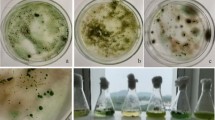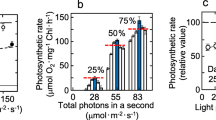Abstract
Microalgal photosynthesis is efficient enough to fix CO2 in both atmosphere and industrially discharged gases, and is a possible future alternative for CO2 reduction. This paper describes physiological responses of microalgal cells to extremely high CO2 concentrations, capability of microalgal cells to fix CO2 at both indoor and outdoor culture experiments, and efforts to establish a culture collection of marine microalgae. Recent researches indicate that microalgae are likely to play a key role in worldwide issues of the coming century.
Similar content being viewed by others
References
Hu, Q., N. Kurano, M. Kawachi, I. Iwasaki & S. Miyachi, 1998a. Ultrahigh-cell-density culture of a marine green alga, Chlorococcum littorale, in a flat-plate photobioreactor. Appl. Microbiol. Biotech. 49: 655–662.
Hu, Q., H. Miyashita, I. Iwasaki, N. Kurano, S. Miyachi, M. Iwaki & S. Itoh, 1998b. A photosystem I reaction center driven by chlorophyll d in oxygenic photosynthesis. Proc. Natl. Acad. Sci. USA 95: 13319–13323.
Iwasaki, I., N. Kurano & S. Miyachi, 1996. Effects of high-CO2 stress on photosystem II in a green alga, Chlorococcum littorale, which has a tolerance to high CO2. J. Photochem. Photobiol. B: Biology 36: 327–332.
Iwasaki, I., Q. Hu, N. Kurano & S. Miyachi, 1998. Effect of extremely high-CO2 stress on energy distribution between PS I and PS II in a 'High-CO2' tolerant green alga, Chlorococcum littorale, and the intolerant green alga, Stichococcus bacillaris. J. Photochem. Photobiol. B: Biology 44: 184–190.
Kawachi, M., M. Kato, H. Ikemoto & S. Miyachi, 1996. Fatty acid composition of a new marine picoplankton species of the Chromophyta. J. appl. Phycol. 8: 397–401.
Kodama, M., H. Ikemoto & S. Miyachi, 1993. A new species of highly CO2-tolerant fast-growing marine microalga for highdensity cultivation. J. Mar. Biotech. 1: 21–25.
Kurano, N., T. Sasaki & S. Miyachi, 1998. Carbon dioxide and microalgae. In Inui T. et al. (eds), Advances in Chemical Conversions for Mitigating Carbon Dioxide Studies in Surface Science and Catalysis, vol. 114. Elsevier Science B.V., Amsterdam: 55–63.
Mitsuhashi, S. & S.Miyachi, 1996. Amino acid sequence homology between N-and C-terminal halves of a carbonic anhydrase in Porphyridium purpureum, as deduced from the cloned cDNA. J. Biol. Chem. 271: 28703–28709.
Mitsuhashi, S., T. Mizushima, E. Yamashita, S. Miyachi & T. Tsukihara, 2000a. Crystallization and preliminary X-ray diffraction studies of a carbonic anhydrase from the red alga, Porphyridium purpureum. Acta Cryst. D56: 210–211.
Mitsuhashi, S., T. Mizushima, E. Yamashita, M. Yamamoto, T. Kumasaka, H. Moriyama, T. Ueki, S. Miyachi & T. Tsukihara, 2000b. X-ray structure of ?-carbonic anhydrase from the red alga, Porphyridium purpureum, reveals a novel catalytic site for CO2 hydration. J. Biol. Chem. 275: 5521–5526.
Miyachi, S., 1995. Diversity of microalgae and their possible application. OECD Documents, Environmental Impacts of Aquatic Biotechnology: 28-31.
Miyashita, H., H. Ikemoto, N. Kurano, S. Miyachi & M. Chihara, 1993. Prasinococcus capsulatus gen. et sp. nov., a new marine coccoid prasinophyte. J. Gen. appl. Microbiol. 39: 571–582.
Miyashita, H., K. Adachi, N. Kurano, H. Ikemoto, M. Chihara & S. Miyachi, 1997. Pigment composition of a novel oxygenic photosynthetic prokaryote containing chlorophyll d as the major chlorophyll. Plant Cell Physiol. 38: 274–281.
Miyashita, H., H. Ikemoto, N. Kurano, K. Adachi, M. Chihara & S. Miyachi, 1996. Chlorophyll d as a major pigment. Nature 383: 402.
Pesheva, I., M. Kodama, M. L. Dionisio-Sese & S. Miyachi, 1994. Changes in photosynthetic characteristics induced by transferring air-grown cells of Chlorococcum littorale to high-CO2 conditions. Plant Cell Physiol. 35: 379–387.
Pronina, N. A., M. Kodama & S. Miyachi, 1993. Changes in intracellular pH values in various microalgae induced by raising CO2 concentrations. XV Int. Botanical Cong., Yokohama, Japan: 419.
Sasaki, T., N. A. Pronina, M. Maeshima, I. Iwasaki, N. Kurano & S. Miyachi, 1999. Development of vacuoles and vacuolar H+-ATPase activity under extremely high-CO2 conditions in Chlorococcum littorale cells. Plant Biol. 1: 68–75.
Seckbach, J., A. F. Baker & P. M. Shugarman, 1970. Algae thrive under pure CO2. Nature 227: 744–745.
Suzuki, E., Y. Shiraiwa & S. Miyachi, 1994. The cellular and molecular aspects of carbonic anhydrase in photosynthetic microorganisms. Progress in Phycological Research 10: 1–54.
Takano, H., H. Takeyama, H. Nakamura, H. Sode, J. G. Burges, E. Manabe, E. Hirono & T. Matsunaga, 1992. CO2 removal by high-density culture of a marine cyanobacterium Synechococcus sp. using an improved photobioreactor employed light-diffusing optical fibers. Appl. Biochem. Bioeng. 34/35: 449–458.
Zhang, K., N. Kurano & S. Miyachi, 1999. Outdoor culture of a cyanobacterium with a vertical flat-plate photobioreactor: effects on productivity of the reactor orientation, distance setting between the plates, and culture temperature. Appl. Microbiol. Biotechnol. 52: 781–786.
Author information
Authors and Affiliations
Rights and permissions
About this article
Cite this article
Kurano, N., Miyachi, S. Microalgal studies for the 21st Century. Hydrobiologia 512, 27–32 (2004). https://doi.org/10.1023/B:HYDR.0000020362.58480.ed
Issue Date:
DOI: https://doi.org/10.1023/B:HYDR.0000020362.58480.ed




